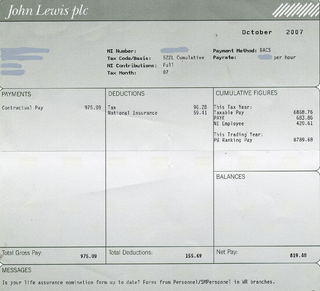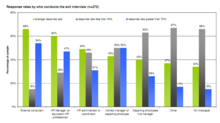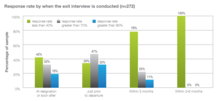A performance appraisal, also referred to as a performance review, performance evaluation, (career) development discussion, or employee appraisal, sometimes shortened to "PA", is a periodic and systematic process whereby the job performance of an employee is documented and evaluated. This is done after employees are trained about work and settle into their jobs. Performance appraisals are a part of career development and consist of regular reviews of employee performance within organizations.

A payroll is a list of employees of a company who are entitled to receive compensation as well as other work benefits, as well as the amounts that each should obtain. Along with the amounts that each employee should receive for time worked or tasks performed, payroll can also refer to a company's records of payments that were previously made to employees, including salaries and wages, bonuses, and withheld taxes, or the company's department that deals with compensation. A company may handle all aspects of the payroll process in-house or can outsource aspects to a payroll processing company.
Staffing is the process of finding the right worker with appropriate qualifications or experience and recruiting them to fill a job position or role. Through this process, organizations acquire, deploy, and retain a workforce of sufficient quantity and quality to create positive impacts on the organization's effectiveness. In management, staffing is an operation of recruiting the employees by evaluating their skills and knowledge before offering them specific job roles accordingly.

Recruitment is the overall process of identifying, sourcing, screening, shortlisting, and interviewing candidates for jobs within an organization. Recruitment also is the process involved in choosing people for unpaid roles. Managers, human resource generalists, and recruitment specialists may be tasked with carrying out recruitment, but in some cases, public-sector employment, commercial recruitment agencies, or specialist search consultancies such as Executive search in the case of more senior roles, are used to undertake parts of the process. Internet-based recruitment is now widespread, including the use of artificial intelligence (AI).
Personnel economics has been defined as "the application of economic and mathematical approaches and econometric and statistical methods to traditional questions in human resources management". It is an area of applied micro labor economics, but there are a few key distinctions. One distinction, not always clearcut, is that studies in personnel economics deal with the personnel management within firms, and thus internal labor markets, while those in labor economics deal with labor markets as such, whether external or internal. In addition, personnel economics deals with issues related to both managerial-supervisory and non-supervisory workers.

Employee engagement is a fundamental concept in the effort to understand and describe, both qualitatively and quantitatively, the nature of the relationship between an organization and its employees. An "engaged employee" is defined as one who is fully absorbed by and enthusiastic about their work and so takes positive action to further the organization's reputation and interests. An engaged employee has a positive attitude towards the organization and its values. In contrast, a disengaged employee may range from someone doing the bare minimum at work, up to an employee who is actively damaging the company's work output and reputation.
In human resources, turnover is the act of replacing an employee with a new employee. Partings between organizations and employees may consist of termination, retirement, death, interagency transfers, and resignations. An organization’s turnover is measured as a percentage rate, which is referred to as its turnover rate. Turnover rate is the percentage of employees in a workforce that leave during a certain period of time. Organizations and industries as a whole measure their turnover rate during a fiscal or calendar year.
Automated telephone surveys is a systematic collection a data from demography by making calls automatically to the preset list of respondents at the aim of collecting information and gain feedback via the telephone and the internet. Automated surveys are used for customer research purposes by call centres for customer relationship management and performance management purposes. They are also used for political polling, market research and job satisfaction surveying.
Employee offboarding describes the separation process when an employee leaves a company. The offboarding process might involve a phased transfer of knowledge from the departing employee to a new or existing employee; an exit interview; return of any company property; and various processes from the company's human resources, information technology, or legal functions.
Talent management (TM) is the anticipation of required human capital for an organization and the planning to meet those needs. The field has been growing in significance and gaining interest among practitioners as well as in the scholarly debate over the past 10 years, particularly after McKinsey's 1997 research and the 2001 book on The War for Talent. Although much of the previous research focused on private companies and organizations, TM is now also found in public organizations
E-HRM is the planning, implementation and application of information technology for both networking and supporting at least two individual or collective actors in their shared performing of HR activities.
Employee surveys are tools used by organizational leadership to gain feedback on and measure employee engagement, employee morale, and performance. Usually answered anonymously, surveys are also used to gain a holistic picture of employees' feelings on such areas as working conditions, supervisory impact, and motivation that regular channels of communication may not. Surveys are considered effective in this regard provided they are well-designed, effectively administered, have validity, and evoke changes and improvements.
Employee retention is the ability of an organization to retain its employees and ensure sustainability. Employee retention can be represented by a simple statistic. Employee retention is also the strategies employers use to try to retain the employees in their workforce.
Employer brand is branding and marketing the entirety of the employment experience. It describes an employer's reputation as a place to work, and their employee value proposition, as opposed to the more general corporate brand reputation and value proposition to customers. The term was first used in the early 1990s, and has since become widely adopted by the global management community. Minchington describes employer brand as "the image of your organization as a 'great place to work' in the mind of current employees and key stakeholders in the external market. The art and science of employer branding is therefore concerned with the attraction, engagement and retention initiatives targeted at enhancing your company's employer brand."
A competency architecture is a framework or model of predetermined skills or "competencies" used in an educational setting. Competency architectures are a core component of competency-based learning.
Human Resource (HR) metrics are measurements used to determine the value and effectiveness of HR initiatives, typically including such areas as turnover, training, return on human capital, costs of labor, and expenses per employee.
Compensation and benefits (C&B) is a sub-discipline of human resources, focused on employee compensation and benefits policy-making. While compensation and benefits are tangible, there are intangible rewards such as recognition, work-life and development. Combined, these are referred to as total rewards. The term "compensation and benefits" refers to the discipline as well as the rewards themselves.
Reward management is concerned with the formulation and implementation of strategies and policies that aim to reward people fairly, equitably and consistently in accordance with their value to the organization.
A human resources management system (HRMS) or Human Resources Information System (HRIS) or Human Capital Management (HCM) is a form of Human Resources (HR) software that combines a number of systems and processes to ensure the easy management of human resources, business processes and data. Human resources software is used by businesses to combine a number of necessary HR functions, such as storing employee data, managing payroll, recruitment, benefits administration, time and attendance, employee performance management, and tracking competency and training records.
A feedback terminal is a physical device that is commonly used to collect large amounts of anonymous real-time feedback from customers, employees, travelers, visitors or students. Typically, feedback terminals feature buttons that users can press to indicate how satisfied they are with the service provided. This information can then be used by organisations to analyze where the experience is optimal, and where it can be improved.




